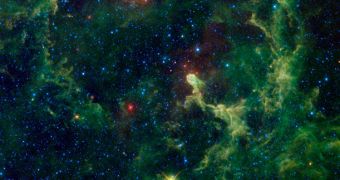The University of California in Berkeley (UCB) Space Sciences Laboratory (SSL) has recently posted a new image of the Elephant's Trunk Nebula on its website. The photograph was taken with the NASA Wide-Field Infrared Survey Explorer (WISE) satellite.
The spacecraft, which launched on December 14, 2009, has been in hibernation mode since completing its primary mission. It took off aboard a Delta II delivery system from Space Launch Complex 2W (SLC-2W), at the Vandenberg Air Force Base (VAFB), in Lompoc, California.
After completing one and a half scans of the entire sky in infrared wavelengths, the satellite was put into hibernation mode pending further use on February 17, 2011. Experts are hoping to use WISE as a means of detecting hidden near-Earth objects (NEO).
Before its was turned off, the telescope managed to observe hundreds of thousands of galaxies, stars and other cosmic objects, including the Elephant's Trunk Nebula. The formation is located in the star cluster IC 1396, which can be found some 2,400 light-years away from Earth.
Located deep within the constellation of Cepheus, this concentration of interstellar gas and dust shines brightly in infrared wavelengths, an indicator that dust is being blown away from the inside out.
Stellar winds and radiations are most likely responsible for the motion WISE detected. Interestingly, the piece of the nebula the new image was focused on appears to be capable of withstanding the assault of winds and radiations, while gas and dust in its surroundings are being dispersed.
All similar nebulae are “Formed in basically the same way – a nearby massive star (or cluster) emitting vast amounts of ultraviolet radiation and stellar winds that clear out all of the gas and dust surrounding it, leaving behind only the most dense parts of the cloud,” SSL experts say in a press release.
“These dense portions then protect some of the gas ‘downwind’ creating a trunk-like feature,” the statement goes on to say. The central star in this nebula is called HR8281, and it can be seen close to the center of this image.
“If you look closely at the tip of the elephant trunk you can see a small dark area, appearing as a sort of opening. This is a small void in the gas formed by a pair of new baby stars that recently formed in the dense cloud,” the team adds.
The entire nebula is estimated to stretch for about 100 light-years from side to side. For comparison, the Milky Way is about 100,000 light-years in diameter. The trunk of the nebula is only 30 light-years across, Universe Today reports.

 14 DAY TRIAL //
14 DAY TRIAL //